I am not sure exactly which species of shrimp is called "amaebi" 甘エビ or sweet shrimp. As opposed to the regular shrimp you eat at sushi bars as sushi, served butterflied and boiled, "amaebi" is served raw. As a result, any kind of shrimp which is served raw appears to be called "amaebi". In the northernmost island of Japan, Hokkaido 北海道 where I am from, our "amaebi" was much larger than those in the rest of Japan. I am not sure if they are a different species or just larger versions of the same species. I initially thought that most of what is called "amaebi" in Hokkaido could be a type of "botanebi" ぼたんえび.
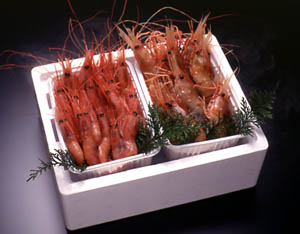 But I found the picture on the left in a Japanese mail order place describing shrimp from Hokkaido and the caption read "...on the left are amaebi and on the right are botanebi..." and, further states "...many people mistake their amaebi as botanebi, since our amaebi are so big..." So, it appears that they are different when amaebi is more narrowly defined. I remember eating amaebi sushi in Tokyo for the first time (when I was in college). They put 2 or 3 amaebi shrimp to make one sushi. I was amazed since I was used to have one shrimp on one sushi; shrimp was more than big enough for one sushi in Hokkaido. In the U.S., there are at least two kinds of shrimp which are being distributed as "amaebi". We used to get "amaebi" from Alaska, twice a year. In spring, we got larger ones with spots on the side which must have been "spot prawns" (similar to "bontan-ebi") and, in fall, we got much smaller shrimp, which may have been "pink shrimp" (similar to "ama-ebi" in the narrow definition described above). We stopped getting these from this particular vendor in Alaska, though. The amaebi came in a plastic container already head removed. Sometimes they were good but many times they were just barely fresh enough to be eaten raw. Now, through Catalina offshore products, we, for the first time, got their "amaebi" or "spot prawns". Again, I am not sure if this is similar to what is called "botanebi" in Japan but they must be very simialr. Certainly, the size appeared very similar as well as the spots on the both sides of the body. They also look similar to what we used to get form Alaska in spring. According to Catalina, their spot prawns are caught in the water off San Diego and was kept alive in a tank until just before shipping, although they do not guarantee the shrimp to be alive upon receipt. They are large and quite fresh (they were not alive when we received them). So, we enjoyed them as a small sashimi and the head was deep fried. I trimmed the antennae and legs with a pair of kitchen scissors and dryed the head with a paper towel (it can splatter badly when deep fried). I deep fried them as is (without any flour or batter) in a medium hot (about 350F) oil for 5-7 minutes. I salted them lightly while they were hot.
But I found the picture on the left in a Japanese mail order place describing shrimp from Hokkaido and the caption read "...on the left are amaebi and on the right are botanebi..." and, further states "...many people mistake their amaebi as botanebi, since our amaebi are so big..." So, it appears that they are different when amaebi is more narrowly defined. I remember eating amaebi sushi in Tokyo for the first time (when I was in college). They put 2 or 3 amaebi shrimp to make one sushi. I was amazed since I was used to have one shrimp on one sushi; shrimp was more than big enough for one sushi in Hokkaido. In the U.S., there are at least two kinds of shrimp which are being distributed as "amaebi". We used to get "amaebi" from Alaska, twice a year. In spring, we got larger ones with spots on the side which must have been "spot prawns" (similar to "bontan-ebi") and, in fall, we got much smaller shrimp, which may have been "pink shrimp" (similar to "ama-ebi" in the narrow definition described above). We stopped getting these from this particular vendor in Alaska, though. The amaebi came in a plastic container already head removed. Sometimes they were good but many times they were just barely fresh enough to be eaten raw. Now, through Catalina offshore products, we, for the first time, got their "amaebi" or "spot prawns". Again, I am not sure if this is similar to what is called "botanebi" in Japan but they must be very simialr. Certainly, the size appeared very similar as well as the spots on the both sides of the body. They also look similar to what we used to get form Alaska in spring. According to Catalina, their spot prawns are caught in the water off San Diego and was kept alive in a tank until just before shipping, although they do not guarantee the shrimp to be alive upon receipt. They are large and quite fresh (they were not alive when we received them). So, we enjoyed them as a small sashimi and the head was deep fried. I trimmed the antennae and legs with a pair of kitchen scissors and dryed the head with a paper towel (it can splatter badly when deep fried). I deep fried them as is (without any flour or batter) in a medium hot (about 350F) oil for 5-7 minutes. I salted them lightly while they were hot.
This is excellent. The meat is fresh tasting and nicely sweet. The deep flied heads are a bit too large but crispy. Although you have to be careful how to chew this to avoid mouth injury, it was mighty good. With the delicate flavor of the shrimp, you have to have a cold sake.
Friday, March 26, 2010
Wednesday, March 24, 2010
Cucumber with moromi miso もろきゅう
This is a teiban 定番 or regular dish in Izakaya. It is very simple dish and this is not a recipe per se; essentially serving cucumber and a special type of miso called moromi miso もろみ味噌 together. It is called "moromi miso kyuri" もろみ味噌きゅうり but it is, almost always, shortened as "morokyu" もろきゅう. The quality of the cucumber is most important. Fresh and firm Japanese cucumber is the best but it is not always easy to get that kind of cucumber in the U.S. It is also interesting to see how Izakayas in different regions serve this dish. For example, last time we were in Japan, we had this in three different Izakayas; one in Kanazawa and two in Kyoto. In Kanazawa, they just served it cut in a long sticks but it was nicely chilled and very crispy. In Kyoto both Izakayas added decorative cuts like I did here as though they feel that an extra touch is need to charge whatever they charge for this dish. I would like to mention another encounter we had in Torihachi とり八 in Kyoto. After we ordered and ate morokyu, a couple (obviously just coworkers or acquaintances) sitting next to us at the counter decided to order one. After receiving the morokyu, the man pontificated on how the decorative cuts could be done (which is far from how this is actually done) and appeared not really interested in eating the dish. We had a chuckle overhearing this.
Especially since I used American mini-cucumbers (my excuse), I did not do a great job of this decorative cut which supposedly mimicking a pine tree. This decorative cut was shown for the first time to us by one of the sushi chefs at Mikado in Tenleytown area of DC, a Japanese restaurant we used to frequent, which has been closed for over 10 years after their losing the lease and the owner decided to retire.
Moromi miso もろみ味噌 is a special kind of miso with fermented rice , wheat or barley, and sometimes with other added vegetables. It tastes salty, sweet and a bit nutty. It is meant to be eaten as a condiment or for dipping but not for seasoning dishes or soup. You could buy it in any Japaneses grocery store and it usually comes in a small plastic pouch (see above) or in a jar. The one I got this time is called "Kinzanji-moromi" 金山寺もろみ which is best known in Wakayam 和歌山 prefecture but this one appears to have come from shinshu 信州 which is Nagano 長野 prefecture.
To eat, just pick up the cucumber and using chopsticks, place and spread a small dab of moromi miso and eat. It is nice refreshing dish in-between other dishes. I have to say, though, nothing matches freshly harvested Japanese cucumber, with a much darker green skin and still having small prickly surface, but this has to do as a good second best. You could also serve sticks of celery, carrots, or other fresh vegetables with moromi miso.
Monday, March 22, 2010
Ginger soy sauce sautéed Pork 豚肉の生姜焼き
Kissaten 喫茶店 is a Japanese coffee shop. You can not quite find the equivalent in the U.S.. Besides coffee and tea, many Kissaten serve a light breakfast or lunch. Many years ago, we used to have these "morning set" breakfasts while we were visiting Japan and stayed in Asakusa 浅草 (These sets typically consist of a boiled egg, small salad, coffee and thick-about one inch-slice of toast with a discounted 2nd cup of coffee). Now, these are mostly replaced by Starbucks or similar Japanese chain coffee shops and the breakfast menus are nearly identical to the U.S. counterparts. Kissaten lunch menus may have included Spaghetti Neapolitan (precooked spaghetti warmed up in ketchup with sautéed mushroom-canned and pre-sliced-, onion, and ham; the Japanese interpretation/invention of a pasta dish, which has no resemblance to the name sake) and Japanese-style curry and rice カレーライス. Some kissaten, near the University I attended (which was eons ago), regularly served a Japanese style "Bento" box lunch beside more common kissaen lunch items. The items in the lunch box changed daily but the most popular and frequent item was the ginger soy sauce sautéed pork or "buta-niku no shouga-yaki" 豚肉の生姜焼き. I think this dish is also perfect for Izakaya.
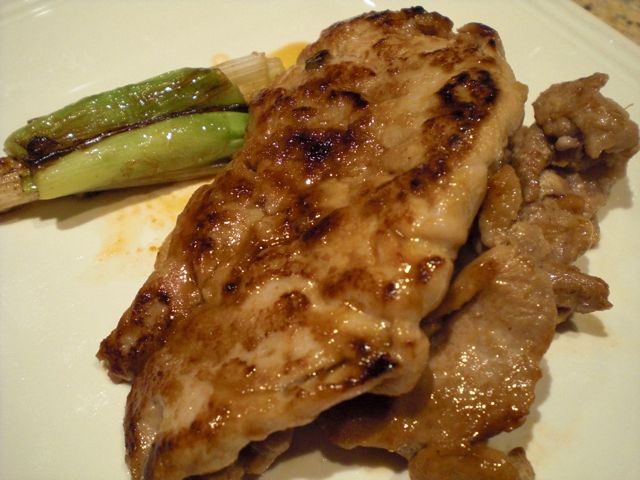
The classic cut of pork used in this dish would have been very thinly sliced pork shoulder or "buta no kata ro-su" 豚の肩ロース肉 (I guess "ro-su" must have derived from "roast"). Here I used small pieces of pork tenderloin thinly pounded. Probably not the best cut of pork for this dish. I marinated thin pieces of pork in a mixture of soy sauce (4 tbs), mirin (2 tbs), and grated ginger (1/2 tsp) for 10 minutes in a Ziploc bag. You could add grated onion (2 tbs) in addition, if you like. I then sautéed the meat with a small amount of olive oil in a frying pan on both side (1-2 minutes each). I added a small amount of marinade (1-2 tbs) at the very end so that the sauce will coat the meat and become glistening. I served this with pan sautéed scallion segments. Although any drinks will go with this dish, I have to have sake.
Saturday, March 20, 2010
Stewed chicken wing with plum 手羽と梅の煮付け
This in on the theme of using plums from making plum wine. I read that you could use plums from plum wine in any stewed meat like chicken wings or pork spare ribs but no "recipe" was provided. I decided just to stew chicken wings (wings and drummets separated with wing tips discarded) with plums and soy sauce flavor.
I placed wings and drummets (6 each) in a colander and poured boiling water over them and then placed them in a saute pan. I filled the remaining space in the pan with the plums which were used to make plum wine. I added enough water (400 to 500 ml or 2-3 cups) to barely cover the chicken. I also put in one scallion (white part) and 3 thin slivers of ginger. I let it simmer for 10-15 minutes with the lid on. I added soy sauce (3 tbs), mirin (2 tbs) and sake (2tbs) and turned up the flame to cook another 10-15 minutes or until the liquid reduces by half or more.
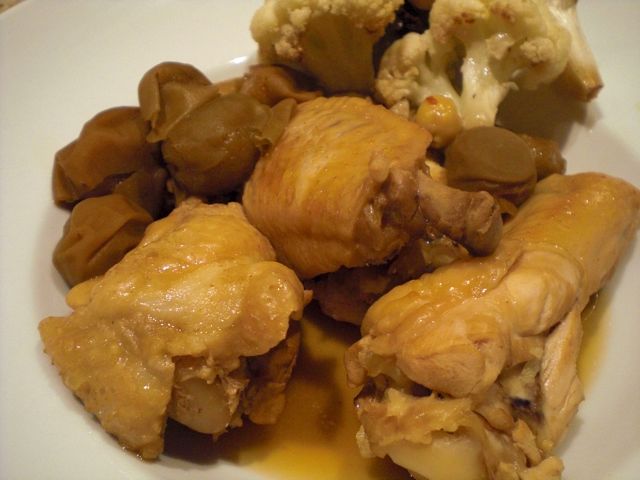
My wife made baked cauliflower with garbanzo beans, black olive, and hot pepper the night before. So I used that as an accompaniment. The plum was soft and tasted plummy with sour and sweet flavor. Chicken is OK but not outstanding. The texture of skin is not the best. We like chicken wings cooked other ways.
Our Japanese plum tree which produced the plums used in the above dish as well as umeshu is in full bloom. Possibly due to the harsh winter, it is flowering late. It often blooms at the end of January or February. We have pictures, taken in previous years, of the blossoms covered in snow. It has a lovely subtle perfume that fills the air. During the day the flowers are covered in a cloud of bees. Where they come from, especially in January we don't know. One thing is for sure this lovely tree beats crocuses as a harbinger of spring.

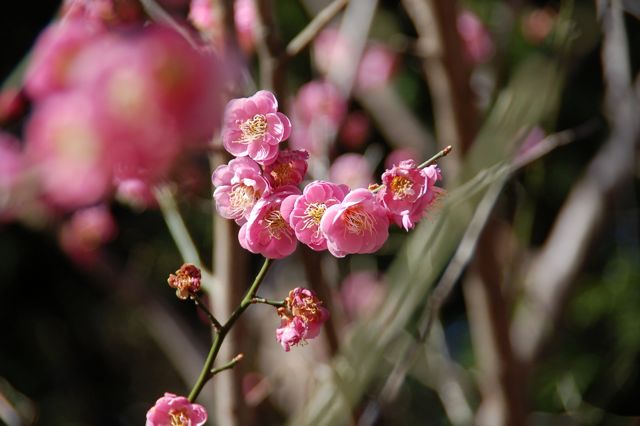
I placed wings and drummets (6 each) in a colander and poured boiling water over them and then placed them in a saute pan. I filled the remaining space in the pan with the plums which were used to make plum wine. I added enough water (400 to 500 ml or 2-3 cups) to barely cover the chicken. I also put in one scallion (white part) and 3 thin slivers of ginger. I let it simmer for 10-15 minutes with the lid on. I added soy sauce (3 tbs), mirin (2 tbs) and sake (2tbs) and turned up the flame to cook another 10-15 minutes or until the liquid reduces by half or more.
Our Japanese plum tree which produced the plums used in the above dish as well as umeshu is in full bloom. Possibly due to the harsh winter, it is flowering late. It often blooms at the end of January or February. We have pictures, taken in previous years, of the blossoms covered in snow. It has a lovely subtle perfume that fills the air. During the day the flowers are covered in a cloud of bees. Where they come from, especially in January we don't know. One thing is for sure this lovely tree beats crocuses as a harbinger of spring.
Friday, March 19, 2010
Squid, cucumber and sea weed salad イカ、胡瓜と海藻の酢みそ和え
This is a rather classic Japanese small salad belonging to a large category of "Sunomono" 酢の物. When sea food is added to the salad, it is most common to use "sumino" 酢みそ as a dressing. I have posted dishes using sumiso before.
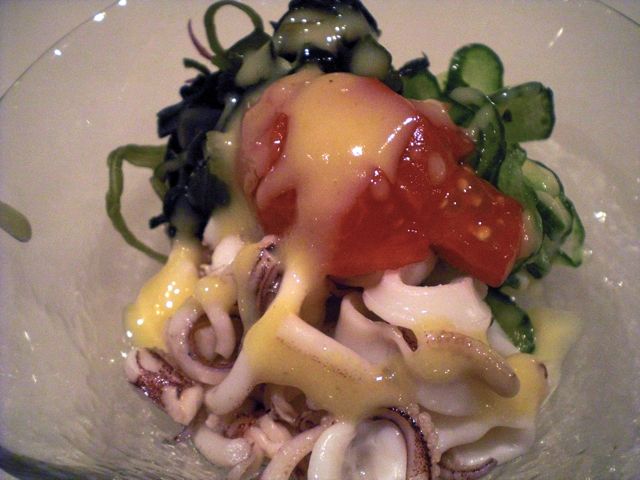
I used boiled squid, seaweed, and cucumber in this dish.
Seaweed: I soak dried "seaweed salad" (comes in a pouch with several kinds of edible seaweeds but you could use just "wakame" 若布) in water and let it rehydrate for 15 or more minutes. Squeeze out excess water and dress it with sushi vinegar and, again, squeeze out excess liquid before assembly.
Squid: I use several bodies and tentacles of very small (body is about 2-3 inch long) cleaned squid. I cook it in boiling water with salt and sake for 30 seconds to 1 minutes (Do not over cook). After removing from the water and tasting, I sprinkle on a bit of salt and sushi vinegar while it is hot and let it cool. If you salted the water enough, you may not need to salt here.
Cucumber: This is an usual treatment of cucumber; I use one mini-cucumber, sliced thinly. I lightly salt the cucumber, mix, and let it stand for several minutes. I ring out the excess water and dress it with sushi vinegar. I, again, squeeze out excess sushi vinegar before assembly.
Dressing ("Karashi sumiso" 芥子酢みそ): I use 2 tsp of sweet miso ("saikyou miso" 西京味噌), 1/3 tsp of prepared Japanse hot mustard (in a tube), 1/3 tsp of sugar, 2 tsp of rice vinegar. After checking the taste and consistency, I add either broth "dashi" or mirin to make adjustment (this time, I added very small amount of mirin).
Assembly: Squeeze out excess shushi vinegar and liquid from the cucumber and seaweed. I arragne the ingredients in three small mounds as you can see in the picture and garnish it with small wedges of skinned Campari tomato and drizzle on the dressing. I used the dressing sparingly since all the ingreidients are already seasoned. The nutty flavor of miso, sweetness and tang of hot mustard punctuated with vinegary taste are perfect in this dish. You definitely need sake for this dish, although some sparkling wines such as Proseco would also go well.
Seaweed: I soak dried "seaweed salad" (comes in a pouch with several kinds of edible seaweeds but you could use just "wakame" 若布) in water and let it rehydrate for 15 or more minutes. Squeeze out excess water and dress it with sushi vinegar and, again, squeeze out excess liquid before assembly.
Squid: I use several bodies and tentacles of very small (body is about 2-3 inch long) cleaned squid. I cook it in boiling water with salt and sake for 30 seconds to 1 minutes (Do not over cook). After removing from the water and tasting, I sprinkle on a bit of salt and sushi vinegar while it is hot and let it cool. If you salted the water enough, you may not need to salt here.
Cucumber: This is an usual treatment of cucumber; I use one mini-cucumber, sliced thinly. I lightly salt the cucumber, mix, and let it stand for several minutes. I ring out the excess water and dress it with sushi vinegar. I, again, squeeze out excess sushi vinegar before assembly.
Dressing ("Karashi sumiso" 芥子酢みそ): I use 2 tsp of sweet miso ("saikyou miso" 西京味噌), 1/3 tsp of prepared Japanse hot mustard (in a tube), 1/3 tsp of sugar, 2 tsp of rice vinegar. After checking the taste and consistency, I add either broth "dashi" or mirin to make adjustment (this time, I added very small amount of mirin).
Assembly: Squeeze out excess shushi vinegar and liquid from the cucumber and seaweed. I arragne the ingredients in three small mounds as you can see in the picture and garnish it with small wedges of skinned Campari tomato and drizzle on the dressing. I used the dressing sparingly since all the ingreidients are already seasoned. The nutty flavor of miso, sweetness and tang of hot mustard punctuated with vinegary taste are perfect in this dish. You definitely need sake for this dish, although some sparkling wines such as Proseco would also go well.
Wednesday, March 17, 2010
Sliced duck breast with orange marmalade sauce 鴨のオレンジママレイドソース
This is my simplified version of Duck a l'Orange. As Japanese believe scallions and ducks are the ultimate combo, the French view classic duck cuisine as canard a l'Orange. Since I was not up to going through with authentic recipes and a roasted duck breast is by itself quite wonderful even without a sauce, I just made an instant sauce using orange marmalade.

I cook duck breast in a classic way. I first clean the breast (remove excess fat and remove any silver skin still attached). I score the skin in a cross hatch pattern (see below) so that fat will render more easily. I rub it with salt (I use Kosher salt) and black pepper liberally since lots come off during the cooking. In a dry frying pan on a medium-low flame, put the duck breast skin side down, after few minutes, fat will come out. You have to remove the excess fat either by tipping the pan or absorbing it using paper towels few times. After 6-7 minutes and the skin is nicely brown and crisp like the image below, turn it over. I place it in a preheated 400F oven for 6-8 minutes or to the doneness of your liking (I cooked for 6 minutes to medium rare. The image below is when the duck just came out from the oven). I then remove the duck breast on a plate, cover it with aluminum foil. If you have rendered the fat properly and removed the excess fat before your place the duck in the oven, there should not be too much excess fat but if you do, leave only 1-2 tsp of fat in the pan. I add minced shallots (one small) and saute for a few minutes and then deglaze it with 1-2 tsp of red wine vinegar and let it reduce almost dry and add 4-5 tbs of port wine (I use a cheap Taylor ruby port) and reduce by half to 1/3 of the original volume. I finish the sauce with 2-3 tbs of orange marmalade. You could add pats of cold butter but I did not. I squeeze fresh lime juice or, if you have one, fresh orange juice, at the very end (just a splash) to add fresh citrus favor to the sauce.
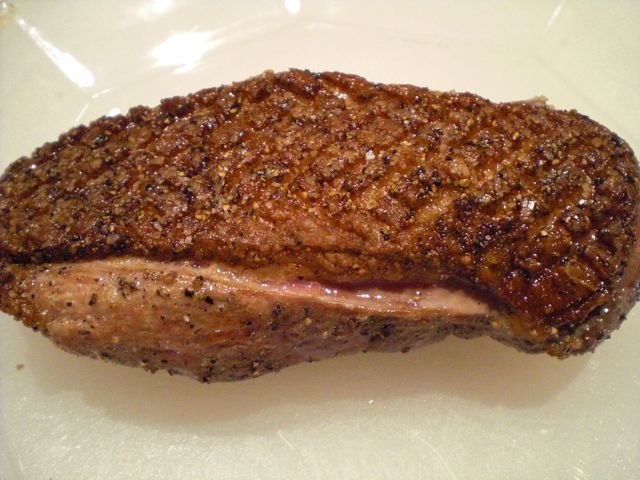
I cook duck breast in a classic way. I first clean the breast (remove excess fat and remove any silver skin still attached). I score the skin in a cross hatch pattern (see below) so that fat will render more easily. I rub it with salt (I use Kosher salt) and black pepper liberally since lots come off during the cooking. In a dry frying pan on a medium-low flame, put the duck breast skin side down, after few minutes, fat will come out. You have to remove the excess fat either by tipping the pan or absorbing it using paper towels few times. After 6-7 minutes and the skin is nicely brown and crisp like the image below, turn it over. I place it in a preheated 400F oven for 6-8 minutes or to the doneness of your liking (I cooked for 6 minutes to medium rare. The image below is when the duck just came out from the oven). I then remove the duck breast on a plate, cover it with aluminum foil. If you have rendered the fat properly and removed the excess fat before your place the duck in the oven, there should not be too much excess fat but if you do, leave only 1-2 tsp of fat in the pan. I add minced shallots (one small) and saute for a few minutes and then deglaze it with 1-2 tsp of red wine vinegar and let it reduce almost dry and add 4-5 tbs of port wine (I use a cheap Taylor ruby port) and reduce by half to 1/3 of the original volume. I finish the sauce with 2-3 tbs of orange marmalade. You could add pats of cold butter but I did not. I squeeze fresh lime juice or, if you have one, fresh orange juice, at the very end (just a splash) to add fresh citrus favor to the sauce.
This sauce has enough orangy, citrus flavors with sweet and sour tastes. It is definitely a classic combo and will particularly go well with red wines, especially syrah or shiraz. We had this with d'Arenberg "The Dead Arm" Shiraz McLaren Vale South Australia 2006, a perfect pairing!
Monday, March 15, 2010
Stewed pork belly redux 豚の角煮再登場
Last time I was experimenting with salt pork to make Pork "kaku-ni" 角煮, it turns out, although the meat was not too salty and the fatty part was cooked just fine, the meaty part became too dry and never got to a melt-in-your-mouth texture (it improved a bit after left in the refrigerator for few days in the broth and reheated before serving). This time, I used bone-in pork spare ribs instead of salt pork. I selected the ribs with the meat from the front part of the pork, i.e. a portion close to the real pork belly. Still this meat is not quite a real pork belly. It does not have the complete layering of meat and fat. Although there is good amount of fat, it is more meaty than pork belly. As before, I used the recipes by Atsushi Tsuchiya 土屋敦.

I used two pork spare ribs (with bone, about 500 grams, meat alone may be about 300 grams). I first remove the bone and cut into 2 inch by 4 inch rectangles. In a small bowl, add 4 tbs of soy sauce (I used 1/3 low sodium soy sauce) and marinate the pork cubes for 10 minutes. Afterwards pat dry the surface of the pork. I brown all sides starting with the fatty side in a dry sauce pan so that some fat will render out first (2-3 minutes on each side). I then add the remaining soy sauce, in which the pork was marinaded, in the pan. I put the pan on a low flame and cook for 5 minutes until the soy sauce reduces a little and becomes slightly viscous. I add abut 200ml of sake, increase the heat and cook 8-10 minutes, and add 3 tbs of sugar.
Meanwhile I soak about 5-6 inch long dried kelp in water and let it rehydrate for 30 minutes or more. Add the water in which the kelp was soaking to the pan above so that the meat is covered. As it comes back to the boil, I skim off the fat and scum which will appear on the surface. I placed the kelp to cover most of the meat and turn down the heat to simmer. I cook about 2 hours on simmer with a lid on, turning the meat over after about 1 hour, adding more water as needed. I let it cool to room temperature and place the pan in the refrigerator.
The next day, I skimmed off any congealed white pork fat and removed the kelp. I warmed up the broth and pork in a low flame for 10 minutes or until thoroughly warmed (avoiding boiling). This time, everything was wonderful. I served it with a dab of hot Japanese mustard, sliced scallion with simply boiled (still crispy) snow peas. The meat is so tender and flavorful. So, to make a Japanese-style stewed pork belly, use the front parts of the pork spare ribs. Salt pork does not work that well. The recipe I used appears better than more common recipes which suggest pre-boiling the pork belly in water before cooking in seasoned broth. As I mentioned before, you could get pork belly from on-line specialty stores, directly from producers, and some Asian markets, which I have not tried. Recently, more and more restaurants are serving Japanese style pork bellies. Our experience has been that the portions they serve is too big and the pork belly is not as tender as it should be. We just can not handle a large amount of this fatty meat, although a small amount is fabulous.
Meanwhile I soak about 5-6 inch long dried kelp in water and let it rehydrate for 30 minutes or more. Add the water in which the kelp was soaking to the pan above so that the meat is covered. As it comes back to the boil, I skim off the fat and scum which will appear on the surface. I placed the kelp to cover most of the meat and turn down the heat to simmer. I cook about 2 hours on simmer with a lid on, turning the meat over after about 1 hour, adding more water as needed. I let it cool to room temperature and place the pan in the refrigerator.
The next day, I skimmed off any congealed white pork fat and removed the kelp. I warmed up the broth and pork in a low flame for 10 minutes or until thoroughly warmed (avoiding boiling). This time, everything was wonderful. I served it with a dab of hot Japanese mustard, sliced scallion with simply boiled (still crispy) snow peas. The meat is so tender and flavorful. So, to make a Japanese-style stewed pork belly, use the front parts of the pork spare ribs. Salt pork does not work that well. The recipe I used appears better than more common recipes which suggest pre-boiling the pork belly in water before cooking in seasoned broth. As I mentioned before, you could get pork belly from on-line specialty stores, directly from producers, and some Asian markets, which I have not tried. Recently, more and more restaurants are serving Japanese style pork bellies. Our experience has been that the portions they serve is too big and the pork belly is not as tender as it should be. We just can not handle a large amount of this fatty meat, although a small amount is fabulous.
Subscribe to:
Posts (Atom)

